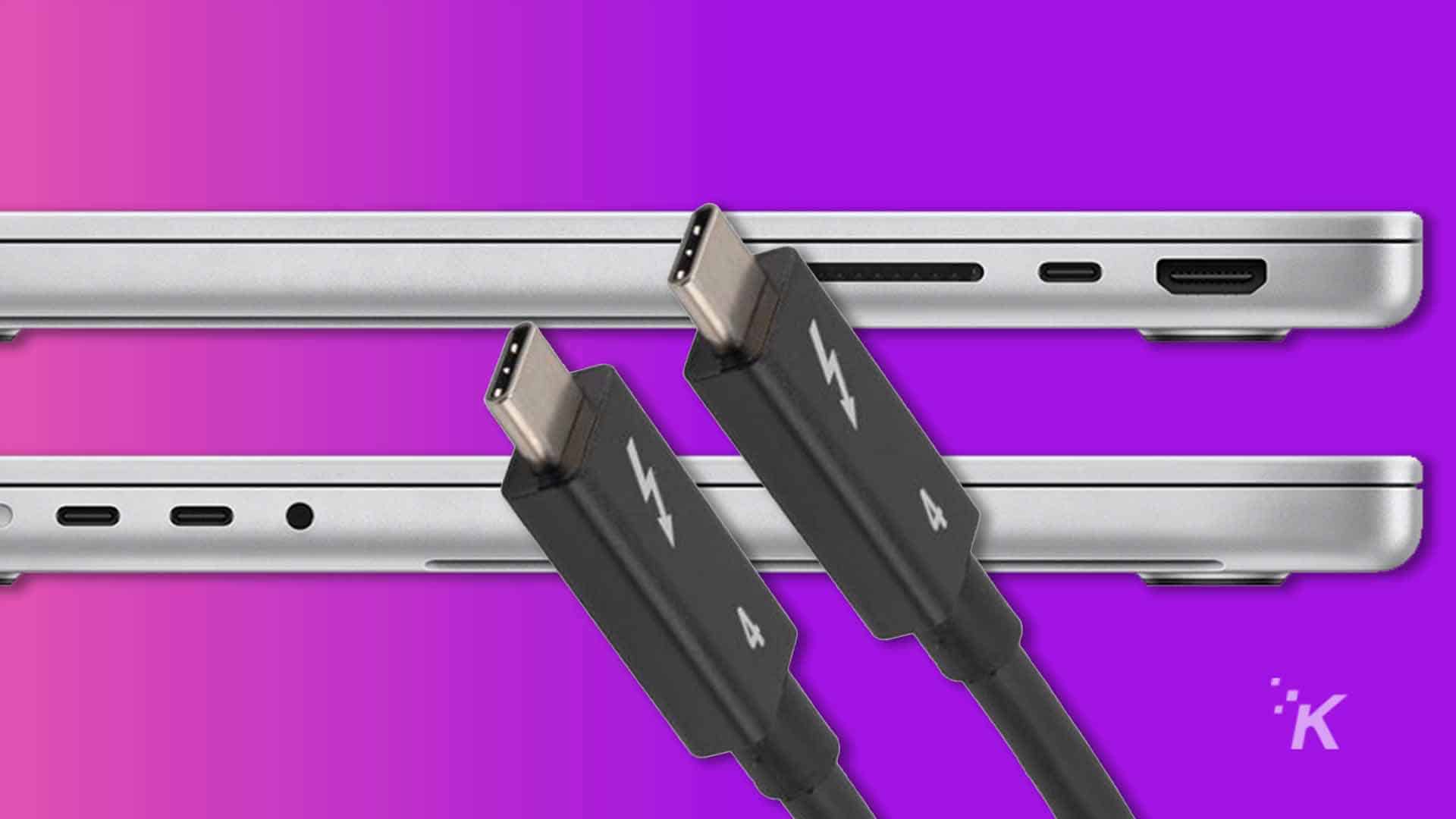FAQs
What is Thunderbolt 4? Super speed ports beyond just USB

Just a heads up, if you buy something through our links, we may get a small share of the sale. It’s one of the ways we keep the lights on here. Click here for more.
Quick Answer: Thunderbolt 4 is a fast, flexible connection type that links a wide range of accessories, including USB and Thunderbolt-enabled devices. It’s compatible with DisplayPort monitors, supporting any standard gaming display.
The ports on our devices are constantly evolving, and keeping up with what everything does isn’t easy.
One minute, we’re trying to figure out up from down as we attempt to connect a classic USB device. Suddenly, it’s Thunderbolt this and Thunderbolt that, with more sequels than a Marvel movie.
Released in 2020, Thunderbolt 4 (or TB4 for short) is the latest high-performance iteration of the common hardware interface.
What exactly is Thunderbolt 4?
Short Answer: It’s basically a way to connect things to your computer.
Not exactly a comprehensive answer, we know. So, let’s discuss Thunderbolt 4—and why it’s so great—in more detail.
Firstly, the newest Thunderbolt ports provide 40 Gbps (gigabits per second) of bandwidth upstream and downstream, so it’s capable of both sending and receiving information at the same rapid rate.
On top of that, TB4 cables provide top transfer speeds at up to 6.56 feet (2 meters) in length, so longer cables won’t negatively affect performance.
Thunderbolt 4’s breakneck speeds aren’t its only big selling point. Yep, there’s more. Mandatory testing and certification for TB4 cables, computers, and accessories ensures performance and reliability across the board.
Basically, when you purchase a reputable Thunderbolt 4 device, you’re getting a quality guarantee.Thunderbolt 4 also offers PCI Express (PCIe) compatibility, which isn’t a given with USB4.
PCIe (peripheral component interconnect express), as well as being an absolute mouthful, is a high-speed interface standard for connecting components to your computer’s motherboard.
With TB4 and the right gear, you can connect PCIe devices to your computer without having to install them internally, which, for many of us, is super convenient.
Also, Thunderbolt 4 ports are versatile. You can connect USB 2, USB 3, and USB4 devices that use the USB-C connection type, and they’ll work perfectly.
If any of your accessories use an older USB A connection or something different, you can, of course, get adapters to make them compatible.
Finally, let’s talk security. In a world where our gadgets are intertwined with our lives, protecting our privacy and security is paramount.
Luckily, TB4 technology uses DMA (direct memory access) protection to prevent external devices from accessing your computer without the appropriate permissions, providing added defense against rascals and scallywags.
What’s the difference between Thunderbolt 3, Thunderbolt 4, and USB4?

We’ve discussed the highlights of Thunderbolt 4, but there’s still a big question remaining: how does it compare to other technology? Let’s find out.
USB4
- Max speed: 20 Gbps
- Max recommended cable length: 2.6 feet (0.8 meters)
- Display capabilities: One monitor
- Mandatory testing and certification: No
Thunderbolt 3
- Max speed: 40 Gbps
- Max recommended cable length: 2.6 feet (0.8 meters)
- Display capabilities: One 4K monitor
- Mandatory testing and certification: Yes
Thunderbolt 4
- Max speed: 40 Gbps
- Max recommended cable length: 6.56 feet (2 meters)
- Display capabilities: Up to two 4K monitors or one 8K monitor
- Mandatory testing and certification: Yes
Essentially, Thunderbolt tech most notably outshines USB4 in the areas of speed and reliability.
When it comes to TB3 versus TB4, the ability of Thunderbolt 4 to maintain top speed with longer cables, and its extra display capabilities make it the superior technology.
What comes after Thunderbolt 4?
Thunderbolt 4 is the logical evolution of its predecessor, Thunderbolt 3. It may not be groundbreaking technology, but it does offer several notable benefits.
Most new, quality computers should come with Thunderbolt 4 as standard. And due to backwards compatibility with previous interfaces, it doesn’t matter if your accessories aren’t specifically designed for TB4.
While Thunderbolt 4 is great, you shouldn’t get too attached to the technology, because Thunderbolt 5 is lurking just around the corner.
Have any thoughts on this? Drop us a line below in the comments, or carry the discussion to our Twitter or Facebook.
Editors’ Recommendations:
- Microsoft upgrades Surface Thunderbolt 4 Dock with USB-C
- A Thunderbolt flaw puts you at risk for local hacking – here’s how to check if you are affected
- What to do when your computer’s USB port stops working
- Apple’s USB-C charging speed cap gets a big “nope” from EU
































